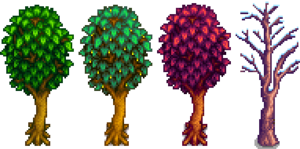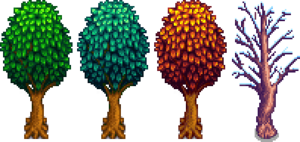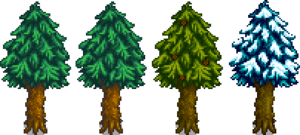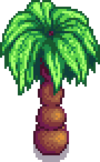Diferencia entre revisiones de «Árboles»
| Línea 1: | Línea 1: | ||
{{Traducir}} | {{Traducir}} | ||
| − | : '' | + | : ''Este artículo trata de árboles no frutales. Para ello acudir a [[Árboles Frutales]].'' |
| − | ''' | + | Los '''Árboles''' que no producen fruta pueden ser de dos tipos: comunes y especiales. Los árboles comunes pueden dar [[Savia]] y [[Madera]] cuando los talas con un [[Hacha]]. Al talar un árbol queda el tocón, el cual se puede cortar para obtener una cantidad pequeña de madera. En cuanto se adquiera el Nivel 1 de [[Recolección]], podrás caer semilas de los árboles que tales. Una semilla correctamente plantada puede tarda 10-12 días en crecer del todo, aunque los árboles no crecen en invierno. Los árboles especiales tienen otras propiedades únicas. Si se cortan árboles fuera de la granja, estos volverán a crecer sin que haga falta plantar una semilla. |
| − | == | + | ==Árboles comunes== |
| − | + | Tres variedades de árboles comunes crecen en [[Stardew Valley]]. Pueden producir resina a través de la [[Resinera]], y la savia y la madera se utilizan para muchas construcciones, fabricaciones, herramientas y armas. | |
| − | + | Para talar un árbol, simplemente hay que golpearlo con el hacha hasta que caiga. Un árbol siempre caerá hacia la derecha o hacia la izquierda, nunca hacia arriba o hacia abajo. Si el jugador lo tala desde la parte derecha, el árbol caerá por la parte izquierda y viceversa. Si se tala desde arriba o abajo, el árbol caerá hacia el lado contrario de donde el jugador se acercó. | |
| − | + | Al caer, los objetos que se consiguen de un árbol (como la madera o las semillas) impactarán contra el suelo sobre el que cae el árbol. Esto es importante cuando están cerca de agua, ya que los objetos que caen en el agua son irrecuperables. Los anillos que atraen objetos son importantes ya que al talar los árboles atraen los objetos que caen y así se minimiza el riesgo de perderlos. | |
| − | Stardew Valley | + | El creador de Stardew Valley [https://twitter.com/ConcernedApe/status/711010819861970944 confirmado por Twitter] especificó que los árboles no crecen de los tocones, al contrario que la opinión pública. Por lo cual, es ideal despejar el lugar de tocones para hacer crecer nuevos árboles con semillas. |
| − | + | Para su máximo crecimiento (10-12 días), las semillas de árboles deben plantarse en zonas que estén despejadas en un área de 5x5 cuadrados. Si hay objetos dentro de ese área, los árboles tardarán más en crecer. Si hay un árbol adyacente a una semilla, esta semilla sólo crecerá hasta su estado jóven como máximo. En invierno, ni los árboles ni las semillas crecerán. | |
Once a tree is fully grown, its surrounding area can be paved without ill effects, although the paving will prevent the tree from dropping seeds. | Once a tree is fully grown, its surrounding area can be paved without ill effects, although the paving will prevent the tree from dropping seeds. | ||
Revisión del 16:56 3 abr 2017

|
Traducción incompleta Este artículo o sección no ha sido completamente traducido al español.
Le invitamos a ayudar en su construcción editándolo |
- Este artículo trata de árboles no frutales. Para ello acudir a Árboles Frutales.
Los Árboles que no producen fruta pueden ser de dos tipos: comunes y especiales. Los árboles comunes pueden dar Savia y Madera cuando los talas con un Hacha. Al talar un árbol queda el tocón, el cual se puede cortar para obtener una cantidad pequeña de madera. En cuanto se adquiera el Nivel 1 de Recolección, podrás caer semilas de los árboles que tales. Una semilla correctamente plantada puede tarda 10-12 días en crecer del todo, aunque los árboles no crecen en invierno. Los árboles especiales tienen otras propiedades únicas. Si se cortan árboles fuera de la granja, estos volverán a crecer sin que haga falta plantar una semilla.
Árboles comunes
Tres variedades de árboles comunes crecen en Stardew Valley. Pueden producir resina a través de la Resinera, y la savia y la madera se utilizan para muchas construcciones, fabricaciones, herramientas y armas.
Para talar un árbol, simplemente hay que golpearlo con el hacha hasta que caiga. Un árbol siempre caerá hacia la derecha o hacia la izquierda, nunca hacia arriba o hacia abajo. Si el jugador lo tala desde la parte derecha, el árbol caerá por la parte izquierda y viceversa. Si se tala desde arriba o abajo, el árbol caerá hacia el lado contrario de donde el jugador se acercó.
Al caer, los objetos que se consiguen de un árbol (como la madera o las semillas) impactarán contra el suelo sobre el que cae el árbol. Esto es importante cuando están cerca de agua, ya que los objetos que caen en el agua son irrecuperables. Los anillos que atraen objetos son importantes ya que al talar los árboles atraen los objetos que caen y así se minimiza el riesgo de perderlos.
El creador de Stardew Valley confirmado por Twitter especificó que los árboles no crecen de los tocones, al contrario que la opinión pública. Por lo cual, es ideal despejar el lugar de tocones para hacer crecer nuevos árboles con semillas.
Para su máximo crecimiento (10-12 días), las semillas de árboles deben plantarse en zonas que estén despejadas en un área de 5x5 cuadrados. Si hay objetos dentro de ese área, los árboles tardarán más en crecer. Si hay un árbol adyacente a una semilla, esta semilla sólo crecerá hasta su estado jóven como máximo. En invierno, ni los árboles ni las semillas crecerán.
Once a tree is fully grown, its surrounding area can be paved without ill effects, although the paving will prevent the tree from dropping seeds.
Maple Tree
Maple Trees grow from Maple Seeds. When tapped, they yield Maple Syrup every 7-8 days. Maple trees have a chance to drop a Hazelnut during Fall.
| Tree | Seed | Stage 1 | Stage 2 | Stage 3 | Stage 4 | Full Grown | Tapper Product |
|---|---|---|---|---|---|---|---|
| Maple Tree |  |
 |
 |
 |
 |
Oak Tree
Oak Trees grow from Acorns. When tapped, they yield Oak Resin every 6-7 days.
| Tree | Seed | Stage 1 | Stage 2 | Stage 3 | Stage 4 | Full Grown | Tapper Product |
|---|---|---|---|---|---|---|---|
| Oak Tree |  |
 |
 |
 |
Pine Tree
Pine Trees grow from Pine Cones. When tapped, they yield Pine Tar every 4-5 days.
| Tree | Seed | Stage 1 | Stage 2 | Stage 3 | Stage 4 | Full Grown | Tapper Product |
|---|---|---|---|---|---|---|---|
| Pine Tree |  |
 |
 |
 |
 |
Special Trees
Special trees have uncommon properties and yields.
Setas gigantes
Big Mushrooms are a rare occurrence on the farm. They do not appear to be plantable, though they do spread like other trees, and yield Red Mushrooms when chopped down.
These trees can be tapped and will yield mushrooms over time.
| Tree | Stage 1 | Stage 2 | Stage 3 | Stage 4 | Full Grown | Tapper Product |
|---|---|---|---|---|---|---|
| Big Mushroom |  |
 |
 |
100px |
Palm Trees
Palm Trees do not drop seeds, but may occasionally drop coconuts when chopped down. They cannot be tapped.
| Tree | Stage 1 | Stage 2 | Full Grown |
|---|---|---|---|
| Palm Tree |  |
 |
 |
Known Bugs
(Version 1.07): Planting a tree inside the Greenhouse on a tilled square will result in "planted seeds" that look similar to parsnips. Hovering above it shows a "pick up" animation, however the seeds simply disappear upon doing so. This bug does not occur when planting a tree on an untilled square.
| Árboles | |
|---|---|
| Árboles | Arce • Palmera • Pino • Roble • Árbol de caoba |
| Árboles frutales | Albaricoquero • Cerezo • Granado • Manzano • Melocotonero • Naranjo • Platanero • Árbol de mango |
| Semillas | Bellota • Piña • Semilla de arce • Semilla de caoba |
| Fruta | Albaricoque • Cereza • Granada • Manzana • Melocotón • Naranja • Mango • Plátano |
| Otros | Árbol seta • Arbusto de té • Tocón grande • Tronco grande |